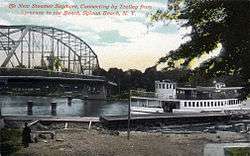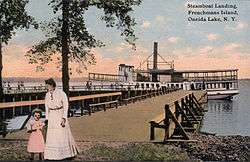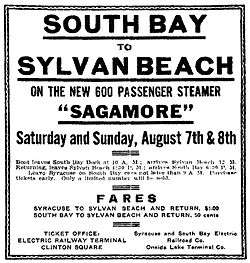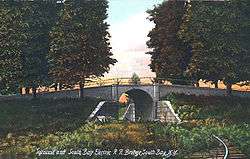Syracuse and South Bay Railway
| Locale | Syracuse, New York through Cicero, New York to South Bay, New York |
|---|---|
| Dates of operation | 1900–1917 |
| Track gauge | 4 ft 8 1⁄2 in (1,435 mm) standard gauge |
The Syracuse and South Bay Railway, also known as the Syracuse and South Bay Electric Railroad, incorporated on May 10, 1900, was an interurban rail that ran from Syracuse, New York, through Cicero to Lower South Bay on the south shore of Oneida Lake, a distance of 12 miles (19 km).[1]
The railway and the steamer, Seneca, combined to provide a round trip from Syracuse to Oneida Lake and across the 1 mile (1.6 km) span to the Frenchman's Island picnic area.[2] The running time from the common center of Syracuse, to South Bay took 35 minutes.[3]
In 1907, the company was sold in foreclosure proceedings and merged into the Beebe Syndicate of railways in Central New York.[4] The name or the road was changed to Syracuse Northern Electric Railway Company by 1917.[5]
History

The Syracuse and South Bay Railway Company was chartered on April 23, 1900, and incorporated on May 10, 1900. The company built a road from the center of the city of Syracuse northeast to Oneida Lake. The company planned to be in operation by February 1906.[6]
By January 1905, eighty percent of the grading for 10 miles (16 km) of double track had been completed. Additionally, the ties and poles were in the ground and the rails had been ordered.[3]
On October 27, 1905, the first electric trolley car, drawn by a steam locomotive, passed over the Syracuse and South Bay Railway carrying directors and officials of the company.[7]
Syracusans could travel north to Oswego to Lake Ontario and points in between via the Syracuse, Lake Shore and Northern Railroad to South Bay and Brewerton on Oneida Lake by way of the Syracuse and South Bay Railway.[2] The road ran from Syracuse to South Bay Road, on the southern shore of Oneida Lake.[1]
Operations
During the planning stages the rolling stock was designated as double-track high speed interurban cars with motors capable of delivering 200 horse power, with 10 open trailer cars to run in conjunction with the larger type. Additionally, 5 box and 5 flat freight cars and 2 electric locomotives of sufficient power to draw a train of 10 trailers. The locomotives were to be used for freight and excursion business.[3]

By 1905, the Syracuse and South Bay Railway had the contracts for the car bodies of ten motor-equipped cars to the J. G. Brill Company of Philadelphia. The Peckham Manufacturing Company won the truck contract and ten trailers were later ordered. Each of the ten cars delivered cost $5,000.[8] By 1906, the company had ten high speed interurban cars and ten trailers.[6]
The general office was located at 305 Gridley Building in Syracuse, New York. Repair shops were situated on the westside of the city.[6]
Electric power
According to an agreement signed in January 1905, the Syracuse Rapid Transit Railway Company furnished power for the road. In the planning stages, it was thought that if necessary, additional power could be obtained from the plant of the Syracuse Lighting Company. Eventually, the company, "in common with other traction lines hereabouts will lease Niagara power."[3]
On August 25, 1908, Niagara power was turned into the transmission lines of the railway between the Solvay substation and North Syracuse. A test of the lines between North Syracuse and South Bay was made the following day and once complete the line was opened at once for business. At that time, the "old Lucebaum farmhouse" at South Bay was remodeled into a temporary station.[9]
Company management
In May 1900, directors of the company included George D. Chapman, James E. Ratchford, Hiram W. Plumb, all of Syracuse and George R. Allen of Cicero.[1]

Officers of the company were president, George D. Chapman; vice-president, Willis B. Burns; secretary, W. R. Kimball; treasurer, Frank L. Barnes; auditor, D. E. Balsby; general manager and purchasing agent, George C. Towle.[6]
In January 1905, Lieutenant Governor W. M. Brown of Pennsylvania, was interested in the company.[3]
By the time the first electric trolley was operational in October 1905, directors and officials included W. B. Burns, L. L. Waters, F. T. Pierson, P. L. Barnes, George T. Skiff, H. W. Plumb, George D. Chapman, George C. Towle, D. E. Balsey, C. P. Hemingway and T. D. MacGregor.[7]
During 1906, directors included; H. R. Plumb, W. R. Kimball, F. T. Pierson, Frank L. Barnes, Willis B. Burns, W. K. Niver, George T. Skiff and L. L. Waters.[6]
E. M. Wharf was hired as an electrical engineer. He also worked in the same capacity for the Syracuse, Lake Shore and Northern Railroad.[10]
By 1908, the company headquarters were located at 500 Onondaga County Savings Bank Building in Downtown Syracuse. F. W. Roebling was vice-president, C. A. Lux was secretary and Willis A. Holden was treasurer.[11]
Financial

The company had authorized and issued $120,000 of capital stock with a par value of $100 per share. The first mortgage consisted of gold bonds issued for $300,000 due in 1935.[6]
Background
The route to Oneida Lake took several years of litigation and the involvement of several roadroads, as well as a "sensational failure," before the operation of a single car to South Bay, New York, a popular resort community. For many years it was the "hope of suburban trolley promoters." Early in the 1890s the work of "getting franchises through the town" to South Bay was begun. This process was repeated "again and again" by multiple companies with the hopes of "immediate" railroad construction only to face failure.[12]
Finally, a breakthrough occurred in 1904 when Willard R. Kimball, former president of the Syracuse Rapid Transit Railway, finally made some progress in the project. On April 12, 1905, the New York State Railroad Commission gave the Syracuse and South Bay Railroad Company permission to build and the Bay Road Construction Company spent the greater part of the year 1905 on construction of the road. The plans were elaborate and "upon the most liberal scale" incorporated the purchase of summer resort hotels, rights of way and a pleasure park at the lake.[12]
Bay Road Construction company
Bay Road Construction Company was established to build the road. On January 19, 1906, there was a flood of judgements filed against the construction company which was followed by a year of litigation and strife for control.[12]
By November 1906, "another fight had developed among different factions" of the company and the history of problems dated back to 1905 when legal judgments were filed against the company. The trouble was in regard to foreclosure action of the Lawrence Savings and Trust Company as trustee against the Syracuse and South Bay Railway Company and others. The mortgage in reference totaled $300,000 and covered all property of the Bay Road Construction Company which was called the Brown mortgage. In defense, attorney for the railway was Louis L. Waters, who represented the directors of the road. The plaintiffs were represented by Ceylon H. Lewis.[13]
Waters represented the Willard R. Kimball interests and it was known that if Brown won the foreclosure action, "it would leave him in absolute control of the affairs of the road." Both sides "got together some time ago" and arranged a compromise and Kimball was given an option on the road which was "extended from time to time," however, Kimball had not been able to secure the necessary backing to complete the road. The fight put up by the Kimball interests to stave off the trial of the foreclosure suit showed the company was "trying to prevent the Brown faction from going on with the road to the exclusion of the Kimball people."[13]
Litigation ended in the case involving the Syracuse and South Bay Railway and South Bay Construction by late November 1907, in a special term of the New York Supreme Court in the confirmation of the report of Attorney Douglas E. Petit as referee in the case of the Lawrence Savings and Trust Company against the rail. The road was sold to Petit in the foreclosure action and Ceylon H. Lewis stated that Clifford D. Beebe now held $300,000 worth of bonds and 92 coupons. Additionally, Charles S. Averill had 53 coupons and Louis Wallis had 8. Four coupons were missing and could not be accounted for. There were another 27 coupons which had been declared null and void.[14]
The report showed that Willard R. Kimball had no interest in the road or in anything connected with it. The coupons held by Averill were formerly the property of Kimball which once totaled 80 in number, with 23 null and void.[14]
Attorney Lewis reported that the referee had received $25,100 as the first payment on the bonds sold. He paid $19,600 in taxes and costs and $1,248 to the Trust company. A trustee of the bonds and the order provided for the payment of $4,500 to Attorneys Lewis and Crowley, who appeared for the Lawrence Savings and Trust Company. The balance was distributed pro rata among the bondholders.[14]

In early 1907, the road was sold upon mortgage foreclosure and Clifford D. Beebe placed a bid for the property for his Beebe Syndicate.[12] There was no objection to the confirmation of the report of sale and all litigation over the rail appeared to be at an end.[14]
Beebe Syndicate
In February 1907, Clifford D. Beebe purchased the railroad property at mortgage foreclosure sale at $251,000 and incorporated it into his Beebe Syndicate of affiliated streetcar and interurban lines across New York State. Beebe announced that the railway construction would be completed.[4]
By November 1907, the Syracuse and South Bay Electric Railroad Company, successor to Syracuse and South Bay Street Railway Company, with offices at 500 Onondaga County Savings Bank Building, were owners of both the Syracuse and Oneida Lake Electric Railway Company and the Syracuse and South Bay Railway Company. President and general manager was Clifford D. Beebe of Syracuse; vice-president, F. W. Roebiling of Trenton, New Jersey; secretary, C. A. Lux; treasurer, A. K. Hiscock; auditor, W. W. Foster; purchasing agent, H. J. Clark; chief engineer, T. H. Mather all of Syracuse and electrical engineer, R. A. Dyer, Jr. of Newark, New York.[15]
Vacation excursions
The railway along with the steamer, Seneca, combined to provide a round trip from Syracuse to Oneida Lake and across the span to Frenchman's Island picnic area. The cost of the trip was 50 cents and there was "no charge for use of island equipment."[2] By 1907, the company owned the park at South Bay and the amusement grounds on both Frenchman Island and Dunham Island at Oneida Lake.[15]
Additionally, there were thrice-weekly excursions to the Thousand Islands and Montreal in Quebec as well as a special trip to Lakeside Park on Owasco Lake, which was called "the prize summer resort of Central New York."[2]

During August 1909, special fares from Syracuse to Sylvan Beach and return cost $1.00 and trips in the reverse direction cost 50 cents. Tickets could be purchased at the Electric Railway Terminal in the Empire Hotel in Clinton Square in Downtown Syracuse or at the Oneida Lake Terminal Company. A new 600 passenger steamer named the Sagamore left the South Bay Dock on Saturday and Sunday at 10:00 am and arrived at Sylvan Beach at 12:00 pm. The return trip left Sylvan Beach at 4:30 pm and arrived in South Bay at 6:30 pm. In order to make the connection, travelers had to leave Syracuse on South Bay cars not later than 9:00 am.[16]
By June 1915, the company was advertising their new boat Jean that was in trials on Oneida Lake. The boat had recently completed a set of trials on the St. Lawrence River. It had six-cylinders developing 100-horsepower for speed with free width of beam to insure safety. At that time, a special, one day, three part ticket permitting stop over at Brewerton, Frenchman's Island and South Bay on either Saturday or Sunday cost 70 cents. The cars departed from the Electric Railway Terminal to both Brewerton and South Bay as early as 8:50am and late as 8:50pm.[17]
Labor union
During June 1916, an agreement with the Amalgamated Association of Street and Electrical Railway Employees was offered to workers from Syracuse and South Bay Railway as well as Empire United lines, Auburn and Syracuse Electric Railroad and the Syracuse, Lake Shore and Northern Railroad. Additionally, the Fulton city lines and Oswego city lines were included in the agreement. Attending the conference were H. J. Barrette and Burton Sampson of the Auburn line, Patrick Long and Willis Pickard of the South Bay road and John Manning and Arthur Hubbell of the Lake Shore road.[18]
Syracuse Northern Electric railway

The rail was formerly the Syracuse and South Bay Railway Company and the name was changed to Syracuse Northern Electric Railway Company by 1917.[5]
South Bay road
The rail first arrived in North Syracuse in 1907 and it was replaced by the South Bay Road in 1932 on "that straight line to the lake" which opened "yet another path for settlers" with automobiles who "looked for places to live" after World War II.[19]
The last link in the new county highway, built on the roadbed of the abandoned Syracuse and South Bay Railway, was completed in September 1938. The highway was extended at that time from the Syracuse-Brewerton Road, from a point about midway between Mattydale and Pitcher Hall, northeast to South Bay. The final stretch of the road to open was between Syracuse-Brewerton Road and Fay Road near North Syracuse. A section of the highway, at the South Bay end was of concrete construction by late 1938 and the remainder was gravel. The new route cut the distance between Syracuse and South Bay.[20]
References
- 1 2 3 "Syracuse-South Bay Railroad". The New York Times. New York, New York. May 11, 1900. Retrieved March 10, 2011.
- 1 2 3 4 Ganley, Joe (March 21, 1997). "Passengers used to travel throughout area by trolley". Syracuse Herald-Journal. Syracuse, New York.
- 1 2 3 4 5 "A Great Resort on Oneida Lake". Syracuse Herald. Syracuse, New York. January 8, 1905.
- 1 2 "25 Years Ago". Syracuse Herald. Syracuse, New York. February 22, 1932.
- 1 2 "152 Miles of Deserted Rights of Way Radiate from Syracuse". The Syracuse Herald. Syracuse, New York. November 5, 1933.
- 1 2 3 4 5 6 McGraw Electric Railway Manual. McGraw Publishing Company: New York, January 1906, p.255. Retrieved March 10, 2011.
- 1 2 "25 Years Ago". Syracuse Herald. Syracuse, New York. October 27, 1932.
- ↑ "36 Miles Ready by 1 January Next". The Post-Standard. Syracuse, New York. March 6, 1905.
- ↑ "Niagara Power Operates Cars on South Bay Line". The Post-Standard. Syracuse, New York. August 26, 1908.
- ↑ Electric traction weekly, Volume 4. Kenfield-Fairchild Publishing Company: Chicago, August 15, 1908, p.828. Retrieved March 10, 2011.
- ↑ Andrew Boyd. Boyd's Duplex Directory of Syracuse. Sampson & Murdock Co., Publishers, 1908, p.32.
- 1 2 3 4 Beauchamp, Rev. William Martin. "Past and present of Syracuse and Onondaga county, New York (Volume 1)". New York: S. J. Clarke Publishing Co., 1908, pg. 492. Retrieved January 14, 2012.
- 1 2 "New Bay Road Fight". The Syracuse Herald. Syracuse, New York. November 13, 1906.
- 1 2 3 4 "Bay Road Fight Ends". The Syracuse Herald. Syracuse, New York. November 23, 1907.
- 1 2 "Electric Railway Directory and Buyer's Manual". Street Railway Journal. New York: McGraw Publishing Company, November 1907, p.81. Retrieved March 13, 2011.
- ↑ "Sagamore". Syracuse Herald. Syracuse, New York. August 5, 1909.
- ↑ "Be Our Guests". Syracuse Herald. Syracuse, New York. June 25, 1915.
- ↑ "Amalgamated Men Preparing Agreement". Syracuse Herald. Syracuse, New York. June 12, 1916.
- ↑ "Village marks milestone". Syracuse Herald-Journal. Syracuse, New York. November 16, 2000.
- ↑ "Last New Highway Link To Be Completed by Fall". Syracuse Herald. Syracuse, New York. August 8, 1938.